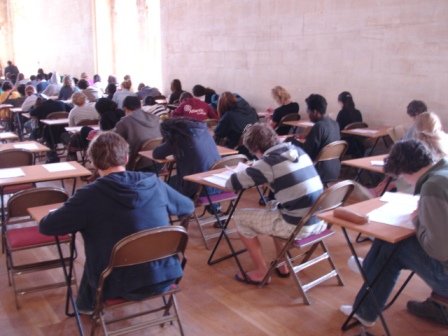Advice to students (Paper 2)
Eleven tips for Paper 2
Preparation
1. Revision. As for Paper 1 go through the syllabus thoroughly checking that you know and understand the chemistry given in the syllabus under 'NoS', 'Understandings', 'Applications and skills' and 'Guidance' for each sub-topic. Check through the gallery of slides for each sub-topic on this site and ensure that you understand all the concepts and the exemplar tasks given.
2. Practice. Practice with Paper 2 questions in two ways. As you revise each sub-topic test yourself with the short answer questions on this site and make sure you fully understand the worked answers. Once you have revised (UK) or reviewed (US) all the topics, practice with past Paper 2 exam papers. Time yourself so that you can be sure to answer all the questions in the time allowed. If you cannot answer a question or get it wrong try to understand what the problem is. You can do this by reading around the topic, checking the information on this site, discussing with other students or by asking your teacher. Learn from your mistakes. Remember that Objective 3 questions require you to think not just regurgitate what is written in the syllabus in the teacher's notes. There is no substitute for a thorough understanding of the underlying concepts.
During the exam

3. Use the reading time wisely. You will have five minutes reading time before the exam starts. During this time you are not allowed to write. It can be helpful to identify a question that you feel very comfortable answering and when you are allowed to write start with this question. This will help you get a good start and allow you to settle in quickly to 'exam mode'.
4. Read each question carefully. Pay particular attention to the command term used. A question which asks you to explain an observation will have a very different answer to a question that asks you to describe the observation. It may sound obvious but if the question asks for two examples then do not give three. If all three are correct then you will not be penalised but if two are correct and one is wrong you will only score one of the possible two marks. If the question asks you to name a product do not just give its formula. When you are asked to define or explain a phrase that is in italics remember to address all the words in italics. For example average bond enthalpy needs an explanation as to what bond enthalpy is as well as what is meant by the word average in this context.
5.Write your answer only in the box provided. The answer papers are scanned and then e-marked. All the examiner sees is what is written in the box. If you write outside the box it may not be scanned and therefore may not be marked. If you make a mistake then cross it out and continue within the box. If you run out of box space write in the box that your answer continues on a separate piece of answer paper - that way the examiner knows to look elsewhere. On the attached paper clearly identify which question it is you are answering and record on the front cover how many extra sheets are attached.
6. Timing. All the questions are compulsory. Be sure to allocate enough time to try to answer all the questions. It is annoying (to say the least) to find that the last question is easy to answer but you have not left yourself enough time to answer it fully.
7. Check the mark allocation. The available marks are given for every question and part question. If there are two marks for a question then there will be two different marking points that are necessary to give in the answer in order to gain both of the marks.
8. Use the correct terminology. Provided you can be understood you will not be penalised for incorrect English. However, you may lose marks if you do not use the correct chemical or scientific language. If you mean potential difference (as in an electrochemical cell) then do not use the word current. Chemicals should have the correct formulas and equations should be balanced. Although it is good practice to include state symbols in equations you will not be penalised if you omit them unless they have been specifically asked for.
9. Show your working. Whenever you do a calculation show how you arrived at your final answer. If the answer is wrong you may still score many of the available marks for using the correct method. This can be especially important if the value from one sub-question is needed for a subsequent question as the same mistake will not be marked wrong twice (this is known to examiners as ECF - error carried forward).
10. Use of Periodic Table. The periodic table gives atomic masses to two decimal places. Because you are able (and expected) to use a calculator you must use the values given to two decimal places whenever they are needed in a calculation.
11. Units and significant figures. For each numerical answer you give check that you have included the correct units (if any) and also check that you have given the answer to the correct number of significant figures. In fact you do have a leeway of one significant figure either way. For example, if the answer should be 1.674 g then 1.67 g, 1.674 g or 1.6742 g would all be acceptable.

 IB Docs (2) Team
IB Docs (2) Team